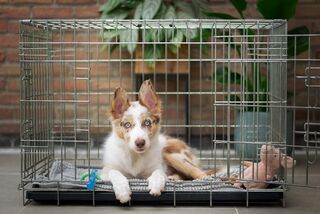Stress
Is It Ethical to Crate Your Dog?
Being locked in can inflict psychological damage.
Posted November 7, 2022 Reviewed by Davia Sills
Key points
- Confining pet dogs to cages has become normalized.
- Being locked in a confined space for extended periods of time inflicts psychological damage on dogs.
- A crate can be a useful tool when provided as a safe space for a dog can go for quiet time with the door open.
- Helping a dog feel comfortable in a crate is a long process that should never involve the use of force.
Although caging dogs and other domestic animals is hardly a new idea, the crate—the cage within a home—has become increasingly popular. Indeed, crates are often included in the things that all responsible dog guardians have and use, and many puppy training books recommend “crate training,” which involves extended periods of confinement to aid in house training. The crate is now so ubiquitous and unquestioned that the noun “crate” has become a verb, a dog-keeping practice: crating. “Just a sec, I’m crating my dog.” But crates and crating practices may be worth a closer look because they have important welfare implications for dogs. A crate is still a cage, and confining animals in cages is ethically problematic.
Aren’t crates just like dens?
Crate aficionados claim that dogs like to be in crates. The crate, they say, is a natural hidey-hole that makes dogs feel calm. A crate is just like a den.
This is a common and sneaky substitution of something unnatural for something natural. Yes, denning is part of maternal behavior in free-ranging dogs and in other canids. But no canid lives in a den beyond early puppyhood. On the contrary, dogs are highly social mammals who need and want to be in close proximity to their family. Isolating a dog in a crate is one of the most unnatural things we do to them.
Why might crates be problematic?
A 1999 paper by animal behavior scientist Bonne Beerda and colleagues in the journal Physiology and Behavior discussed the successful use of social and spatial restriction to induce chronic stress in a group of laboratory beagles. Dogs were confined to individual crates for six weeks, with no social interaction or even visual access to other dogs. The socially and spatially restricted dogs “exhibited a heightened state of aggression, excitement, and uncertainty” and showed hormonal and immunological changes associated with high levels of stress."[i] How is crating a pet dog in the home different from what is described in this article as “social and spatial restriction”? What period of daily crating for a pet dog would lead to chronic stress? One hour? Eight hours? Twelve hours?
When talking to people about their crating practices, I often sense an undertone of discomfort. Unprompted, people will tell me they do have a crate and that they “crate-trained” their puppy. “But,” they will quickly add, “we don’t ever lock the crate door now. And Bailey actually loves her crate. She goes in there all on her own when she wants to feel safe.”
This calls to mind the seemingly counterintuitive behavior of ex-prisoners who long for the safety of confinement. But the message to draw from this is not that incarcerated people want to remain locked up because they enjoyed their time in prison. The psychological motivation is trauma; the chronic loss of free choice changes people. It almost certainly also changes dogs, too. And being in a crate, whether as a puppy or an adult, involves a chronic loss of free choice.
Most crates sold by pet stores are too small.
Like the shock collar, a crate is a familiar tool within the context of the extreme exploitation of dogs in laboratory research. Oddly, the guidelines about appropriate cage size set forth by the U.S. Department of Agriculture—which is not known to be a great friend to animal-kind—are more rigorous than those typically applied by individual dog guardians. In fact, individual dog guardians have no legal requirement to follow the USDA’s Animal Welfare Act guidelines, nor are there any limitations on how dog cages or crates can be marketed and sold. My guess is that nearly all crates used to confine pet dogs would be judged by the USDA as too small.
I followed the USDA calculations to find the right size crate for my dog, Bella: Bella is about 39” long. So, the floor size of her crate would need to be 14 square feet. The size recommendation on Chewy’s website for Frisco Fold & Carry (which looks like the crate we have for Bella) is more like 8 square feet, and that’s assuming I ignore the “your pet’s weight” column, which would have put Bella in a medium size, 5.75 square feet. The only consolation here for Bella is that she doesn’t live in her crate the way dogs in a research facility or commercial breeding operation would. The crate is folded up in our basement and is only there for veterinary emergencies.
There is a time and place for crates, but the door should be open (except in emergencies).
Like muzzles, crates are a tool with great value in a very narrow range of situations. We should consider it a kindness to help all dogs learn to feel comfortable in a crate. The crate—with the door wide open—can be a safe place for a dog to go when he or she would like some time alone, needs refuge from screaming children, other pets, and so forth. Used in this way, the crate increases a dog’s autonomy because she can opt-out of social interactions with others in the household.
There is also value in helping a dog feel comfortable in a crate with the door closed because there may be times when such confinement is important for the dog. The most obvious example that comes to mind is during an illness or after surgery, when a dog may need to be kenneled at the veterinary clinic and while in recovery at home. If being crated is familiar and has positive associations—lots of treats and praise, minimal fear or anxiety—then the stress of the surgery or illness may be somewhat reduced.

Too often, though, crating is a practice that serves us rather than our dogs. Crating allows us to go about our own lives without worrying about a dog peeing on our rug or chewing on our furniture. But this doesn’t necessarily serve our dogs. We should be mindful about our crating practices and make sure they are primarily serving the interests of our companions. In this spirit, we might consider getting rid of the term “crate” and instead just say “cage.” “Crating” is a euphemism that blunts our moral curiosity; to “crate your dog while you are away from the house” sounds benign. "Cage your dog," on the other hand, may raise little red flags in our minds--as it should.
Shaping the way crates are marketed, sold, and described in training literature could help reduce and refine their use by dog guardians by shifting the narrative from the patently absurd “all responsible dog owners use a crate” to the more reasonable “this is a tool you might consider having around, but it should be used with extreme caution.”
Facebook image: Amber Aquart/Shutterstock
References
Beerda B, Schilder MB, van Hooff JA, de Vries HW, Mol JA. Chronic stress in dogs subjected to social and spatial restriction. I. Behavioral responses. Physiol Behav. 1999 Apr;66(2):233-42. doi: 10.1016/s0031-9384(98)00289-3. PMID: 10336149.
Beerda B, Schilder MB, Bernadina W, van Hooff JA, de Vries HW, Mol JA. Chronic stress in dogs subjected to social and spatial restriction. II. Hormonal and immunological responses. Physiol Behav. 1999 Apr;66(2):243-54. doi: 10.1016/s0031-9384(98)00290-x. PMID: 10336150.




